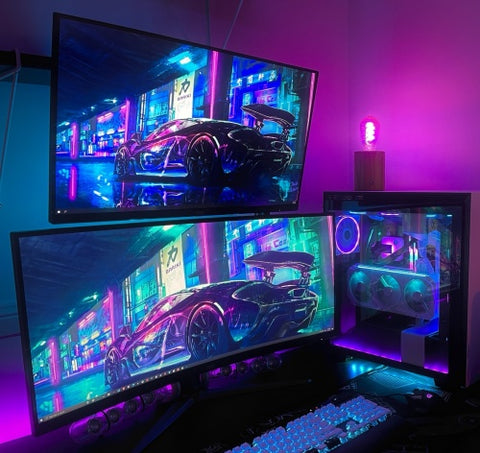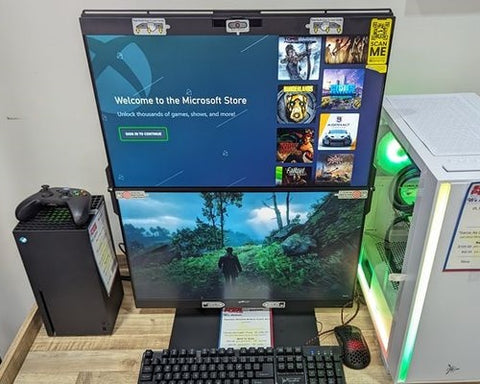Stacking monitors is an excellent way to maximize your workspace and boost productivity. By placing one monitor on top of another, you can create a more ergonomic setup that saves desk space and allows you to work more efficiently. In this ultimate guide, we'll explore the benefits of stacked monitor setups and provide you with step-by-step instructions on how to achieve the perfect configuration for your needs.
The Ultimate Guide to Stacking Monitors
Why Stack Monitors?
When it comes to monitor setups, there are two main options: stacked or side-by-side. While both have their advantages, stacked monitors offer several unique benefits that make them a popular choice among professionals and enthusiasts alike.
One of the main advantages of stacking monitors is the space-saving aspect. By placing one monitor on top of another, you can free up valuable desk space that would otherwise be taken up by a side-by-side setup. This is particularly beneficial for those working in small workstations or with limited desk real estate.
In addition to saving space, stacked monitors can also improve your focus and efficiency. With a stacked setup, you can dedicate one monitor to your primary task while using the other for reference materials, communication tools, or other secondary tasks. This allows you to keep your main focus on one screen while still having easy access to other important information.
Choosing the Right Equipment
To create the perfect stacked monitor setup, you'll need to choose the right equipment. This includes selecting the best monitor stands or mounts, as well as considering any DIY solutions that may work for your specific needs.
One popular option for stacking monitors is the VIVO Dual Monitor Vertical Desk Mount. This mount allows you to securely stack two monitors on top of each other, with adjustable height and tilt options for optimal viewing angles. Other alternatives include the Mount-It! MI-2752 Dual Monitor Desk Mount and the AmazonBasics Premium Dual Monitor Stand.
If you're on a tight budget or prefer a more customized solution, you can also consider DIY options. For example, you could create your own monitor stand using wood or other materials, or repurpose existing furniture items like shelves or bookcases to hold your monitors.
Ergonomic Setup for Stacked Monitors
When setting up your stacked monitors, it's important to consider ergonomics to ensure a comfortable and healthy working environment. This includes adjusting the height and distance of your monitors, as well as optimizing the lighting and ambient conditions in your workspace.
Ideally, your monitors should be positioned so that the top of the screen is at or slightly below eye level. This helps to reduce neck strain and promote good posture. The distance between your eyes and the monitors should also be considered, with a recommended range of 20-30 inches for optimal viewing.
In terms of lighting, it's best to avoid harsh overhead lights or direct sunlight that can cause glare on your screens. Instead, opt for soft, diffused lighting that illuminates your workspace evenly. You may also want to consider using an anti-glare screen protector or adjusting the brightness and contrast settings on your monitors to reduce eye strain.
Also see: Arzopa A1M Portable Laptop Monitor
Upgraded built-in single bracket. You don't need to carry a separate stand to position the monitor horizontally and vertically. The bracket can support multiple Angle adjustment and you can esily use it whenever and wherever you like.
Arzopa A1M Portable Laptop Monitor | 1080P 17.3'' FHD IPS

- Large 1080P Portable Screen,delivers you a vivid image, clear motion and detail.
- Compatible for laptops, PC, Phones, PS5, XBOX, Switch, etc.
- 3 in 1 display mode: duplicate mode, extend mode, second screen mode.
- Plug and Play,simply connect with one USB-C cable for video signal and power.
Setting Up Your Stacked Monitor Desk
Once you have your equipment and ergonomic considerations in mind, it's time to physically set up your stacked monitor desk. This process can vary depending on the specific equipment you're using, but here are some general steps to follow:
-
Start by assembling your monitor stand or mount according to the manufacturer's instructions. Make sure all screws and bolts are tightened securely.
-
If you're using a DIY solution like a wood shelf, make sure it's sturdy and level before proceeding.
-
Carefully place your monitors on the stand or mount, making sure they are centered and aligned properly.
-
Adjust the height and tilt of your monitors as needed to achieve the optimal viewing angle and distance.
-
Use cable ties or other cable management solutions to keep your cords organized and out of sight.
For a more customized look, you can also consider creating your own DIY monitor shelf using wood or other materials. This allows you to tailor the size and style of your setup to your specific needs and preferences.
Navigating Stacked Monitors
Once your stacked monitors are set up, you'll need to configure your operating system to recognize and utilize both displays effectively. The process for this varies slightly between Windows and macOS, but here are the general steps:
Windows:
- Right-click on your desktop and select "Display settings".

- Click on the "Identify" button to determine which monitor is which.

- Drag and drop the monitor icons to match their physical arrangement.
- Select "Extend these displays" to use both monitors as one continuous display.

macOS:
- Click on the Apple menu and select "System Preferences".

- Click on "Displays".
- Click on the "Arrangement" tab.

- Drag and drop the monitor icons to match their physical arrangement.
- Make sure the "Mirror Displays" checkbox is unchecked to use both monitors as one continuous display.
In addition to configuring your operating system, there are also several software solutions available that can help you manage your stacked monitors more efficiently. These include tools like DisplayFusion, Actual Multiple Monitors, and UltraMon, which offer features like custom hotkeys, multi-monitor taskbars, and easy window management.
Gaming with Stacked Monitors
While stacked monitors are often associated with productivity and professional use cases, they can also be a great option for gaming. By using a stacked setup, you can create a more immersive gaming experience that takes advantage of the increased screen real estate.
One popular configuration for gaming with stacked monitors is to use an ultrawide monitor on the bottom and a smaller, secondary monitor on top. This allows you to dedicate the main screen to your game while using the secondary monitor for things like chat windows, game guides, or streaming tools.

Another option is to use two identical monitors stacked on top of each other, which can create a more seamless and continuous display for games that support multi-monitor setups. This can be particularly effective for racing or flight simulation games, where the increased vertical screen space can provide a more realistic and immersive experience.

When gaming with stacked monitors, it's important to consider the performance impact on your system. Running multiple monitors can be more demanding on your graphics card and CPU, so you may need to adjust your game settings or upgrade your hardware to maintain optimal performance.
Real-life Examples & Testimonials
To get a better sense of how stacked monitors can benefit users in real-world scenarios, let's take a look at some examples and testimonials from the community:
Productivity Example:
"As a software developer, I find that having two stacked monitors is a game-changer for my workflow. I can keep my code editor on one screen while using the other for documentation, debugging tools, and communication apps like Slack. It allows me to stay focused on my main task while still having easy access to all the resources I need." - John D., Software Developer
Gaming Example:
"I recently switched to a stacked monitor setup for gaming, and I'm never going back. I use a 34-inch ultrawide on the bottom for my main game display, and a 24-inch monitor on top for Discord, Twitch chat, and other tools. It's amazing how much more immersed I feel in the game when I have all that extra screen space to work with." - Sarah K., Gamer
These examples demonstrate how stacked monitors can be beneficial for both productivity and gaming use cases, providing users with increased screen real estate, improved focus, and a more immersive experience overall.
Common Questions & Concerns
Despite the many benefits of stacked monitors, there are also some common questions and concerns that users may have when considering this setup. Here are a few of the most frequently asked questions:
Q: Can stacked monitors cause neck strain or other ergonomic issues?
A: While it's true that stacked monitors can potentially cause neck strain if not set up properly, this can be easily avoided by following ergonomic best practices. Make sure your monitors are positioned at the correct height and distance, and take regular breaks to stretch and rest your eyes.
Q: Will my monitors be compatible with a stacked setup?
A: In most cases, any modern monitor should be compatible with a stacked setup as long as you have the appropriate mounting equipment. However, it's always a good idea to double-check the specifications of your monitors and the mount or stand you plan to use to ensure compatibility.
Q: Is it safe to stack monitors on top of each other?
A: Yes, as long as you use a sturdy and reliable mount or stand that is rated for the weight and size of your monitors. Avoid using makeshift or DIY solutions that may not be stable enough to support the weight of your displays.
By addressing these common concerns and following best practices for ergonomics and safety, you can enjoy all the benefits of a stacked monitor setup without any of the potential drawbacks.
Conclusion
In conclusion, stacking monitors can be an excellent way to boost your productivity, save desk space, and create a more immersive computing experience overall. By following the tips and guidelines outlined in this ultimate guide, you can achieve the perfect stacked monitor setup for your specific needs and preferences.
Whether you're a professional looking to streamline your workflow, a gamer seeking a more immersive experience, or simply someone who wants to maximize their desk space, stacked monitors are definitely worth considering. So why not give it a try and see how much of a difference it can make in your daily computing life?
We'd love to hear your thoughts and experiences with stacked monitor setups in the comments below. And if you found this guide helpful, please consider sharing it with your friends and colleagues who may also benefit from this information. Happy stacking!












